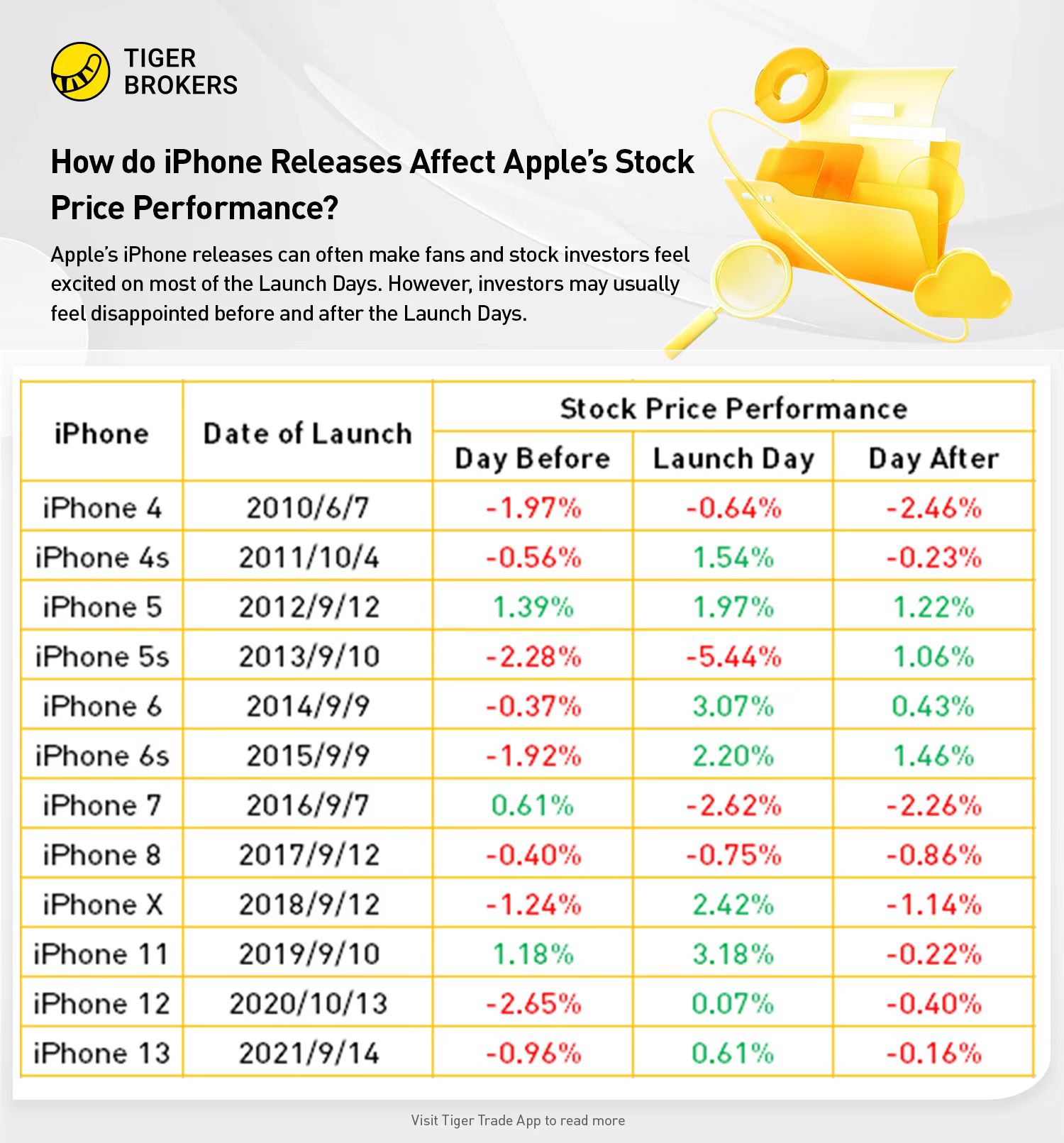Apple announced it will hold a press event on Sept. 7 at 1 p.m. ET where it’s expected to announce new iPhones.
It is expected to release four new iPhone models that will likely be called the iPhone 14. The new devices will have improved cameras, and the more expensive iPhone 14 Pro versions could have a smaller pill-shaped cutout on the top of the device’s display, versus the “notch” that current iPhones have, and will reportedly include always-on displays.
So how do iPhone releases affect Apple’s stock price performance, according to the picture below, Apple’s iPhone releases can often make fans and stock investors feel excited on most of the Launch Days. However, investors may usually feel disappointed before and after the Launch Days.
April 2010: Apple Releases the First iPad
On April 3, 2010 Apple released its first iPad. The company’s stock price had no major reaction when the market opened on Monday, April 5, but its stock price rose 13% by the end of the month. Although the stock price did well the month of its iPod release, the increase was partially due to better than expected earnings released at the end of the month.
Since the release of Apple’s original iPad, there have been four other iPads released including the iPad Mini.
September 9, 2014: The iPhone 6 & iWatch are Launched
The iPhone 6, iPhone 6 Plus and iWatch were launched on September 9 and then later released on September 19. During the first weekend, Apple sold 10 million units of its iPhone – more than any other iPhone in the past.
Despite the enormous amount of sales, the stock suffered after reports that the phone was prone to bending.
iPhone 7/7 Plus: Stocks Appeared Rocky
Since the launch of the iPhone 6 in 2014, Apple has expanded its product offerings to appeal to a wider audience. This began with the iPhone 7, which also included an iPhone 7 Plus model. With the latest round of iPhones, Apple has introduced more affordable options alongside its premium edition as a means of growing its business in emerging markets.
From a stock perspective, this strategy appeared rocky at first, with share prices stagnating and even declining between 2015 and 2016.
The iPhone 7 and iPhone 7 Plus were announced on Sept. 7, 2016 and released less than two weeks later. The announcement of the new iPhones sent AAPL shares tumbling, but the decline was short-lived after the company announced it had sold out of all initial quantities of the iPhone 7 Plus ahead of the Sept. 16 launch. T-Mobile also announced that the iPhone 7 had broken the carrier’s single-day pre-sale record.
iPhone X: Shares Touched Multiple Record Highs
The election of Donald Trump to the presidency in November 2016 was a boon to Wall Street and information technology stocks in particular. In the process, Apple shares touched multiple record highs.
Apple’s strategy shifted again in 2017 when the company announced the $1,000 iPhone X – a steep asking price in the highly saturated smartphone market. The iPhone X was announced on Sept. 12 alongside the iPhone 8 and iPhone 8 Plus models. The phones were released on Nov. 3. Share prices fluctuated during the announcement, declining sharply toward the end of September before rebounding markedly ahead of launch day. About one week after launch, AAPL was back at record highs.
Although the iPhone X received glowing reviews, the product has suffered from lower-than-expected demand, with analysts downgrading their sales targets for the product. The company’s Q4 2017 earnings report showed a 1% drop in total iPhone sales from a year ago.
It remains to be seen whether higher-end models like the iPhone X will remain part of Apple’s long-term strategy. Share prices have held up fairly well since the announcement even as the broader market experienced a massive correction at the start of February.
Wedbush:iPhone 14 Launch Event Is Another Pivotal Moment for Apple
A Wedbush analyst remains bullish on Apple ahead of the much-anticipated iPhone 14 launch event on September 07.
Supply chain checks on Apple proved to be “very firm” as far as the initial order for 90 million iPhone 14 units is concerned.
“This speaks to the underlying demand story that Apple anticipates for this next iPhone release with our estimates that 240 million of 1 billion iPhone users worldwide have not upgraded their phones in over 3.5 years,” the analyst said in a client note.
He is especially positive amid the strong average selling prices (ASPs) amid a consumer shift to iPhone Pro and Pro Max.
“While the base iPhone will stay at the same price we believe a $100 price increase on the iPhone 14 Pro/Pro Max is likely in store given component price increases as well as added functionality on this new release,” the analyst added.
He sees a “likely low bar” for Apple to beat as the Street looks for the company to ship out about 220 million iPhone units in FY23.
“In the key China region we estimate that roughly 30% of iPhone consumers are in the window for an upgrade cycle,” the analyst concluded.

Comments